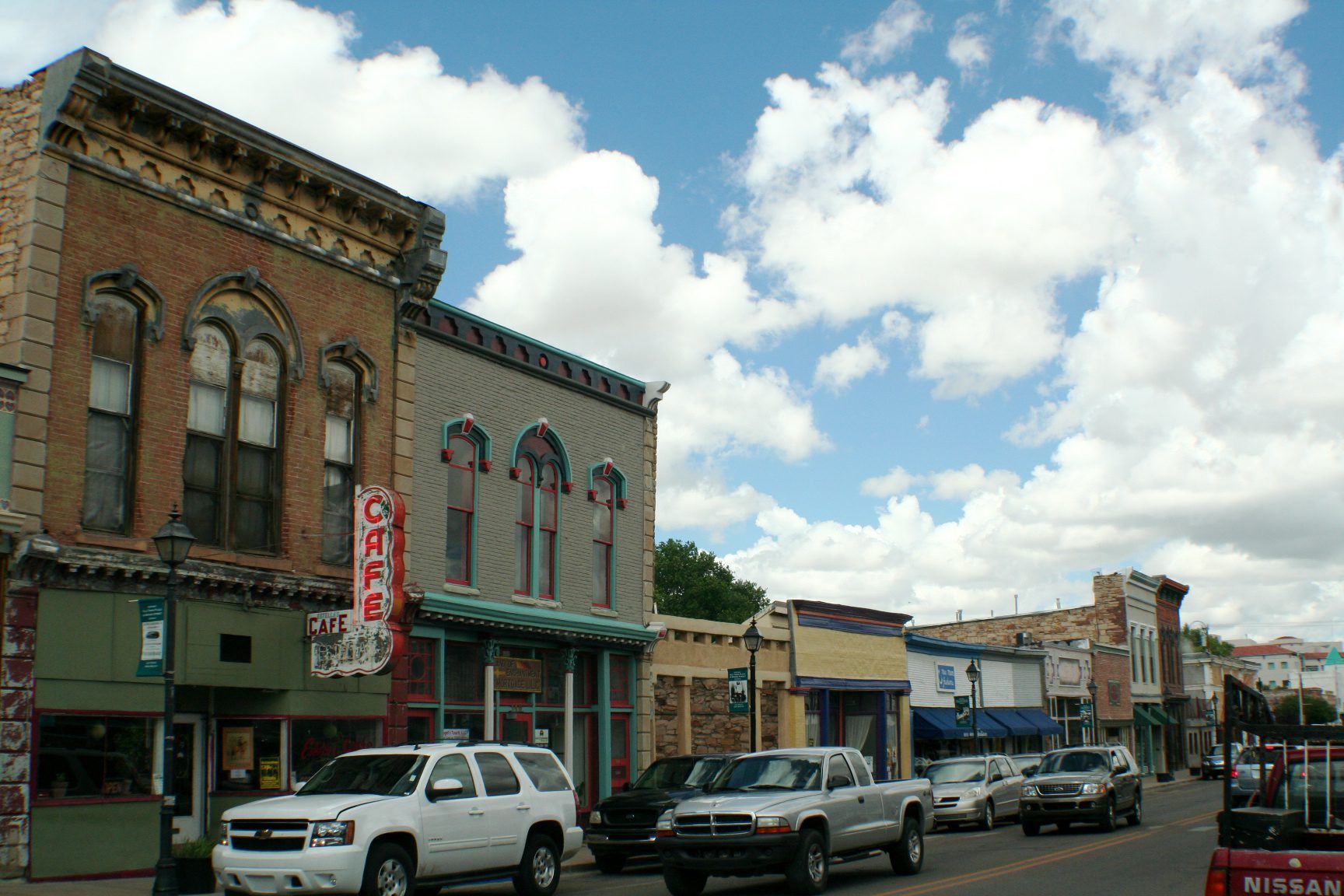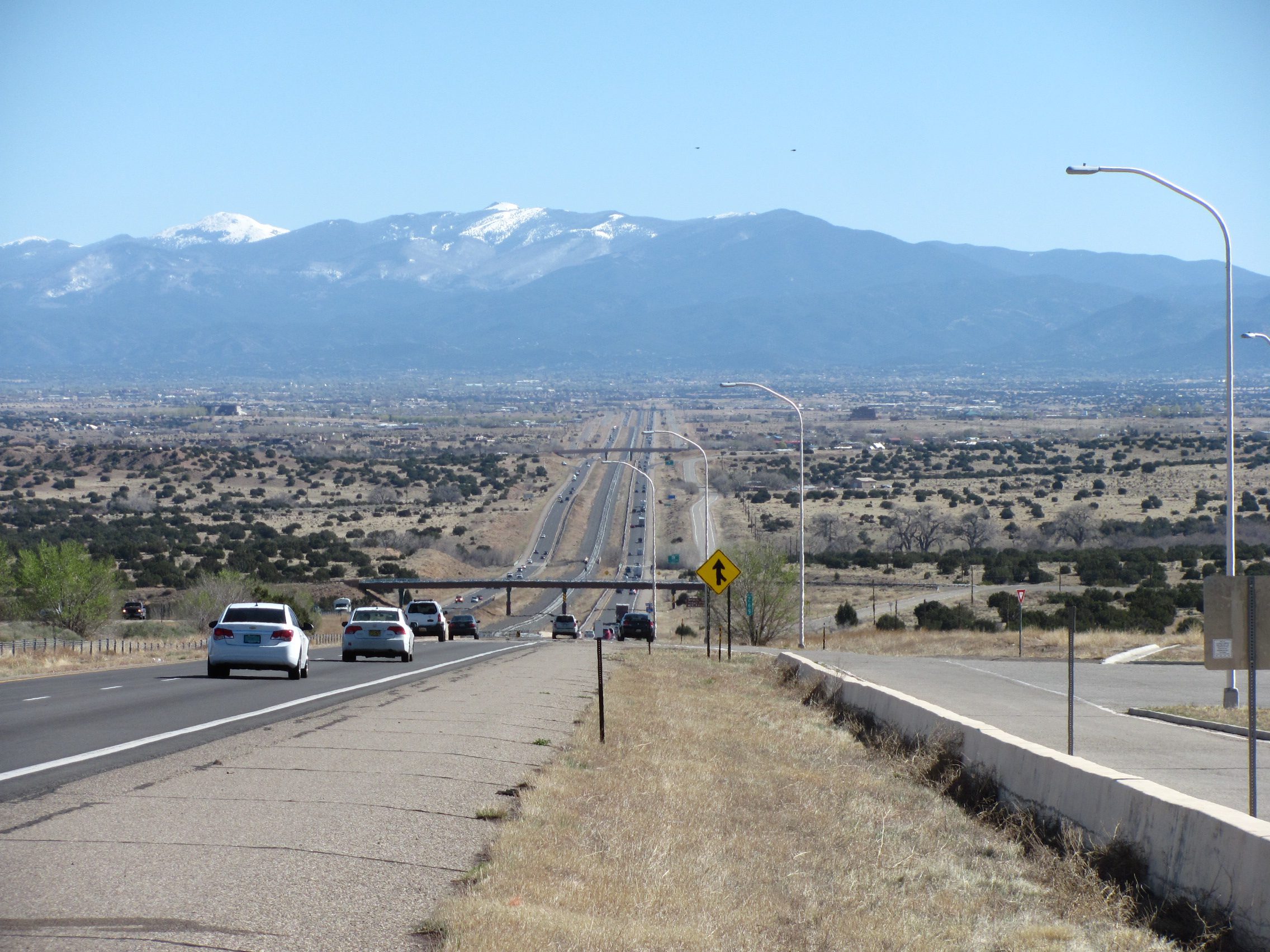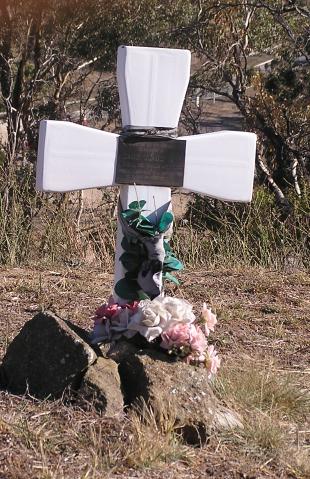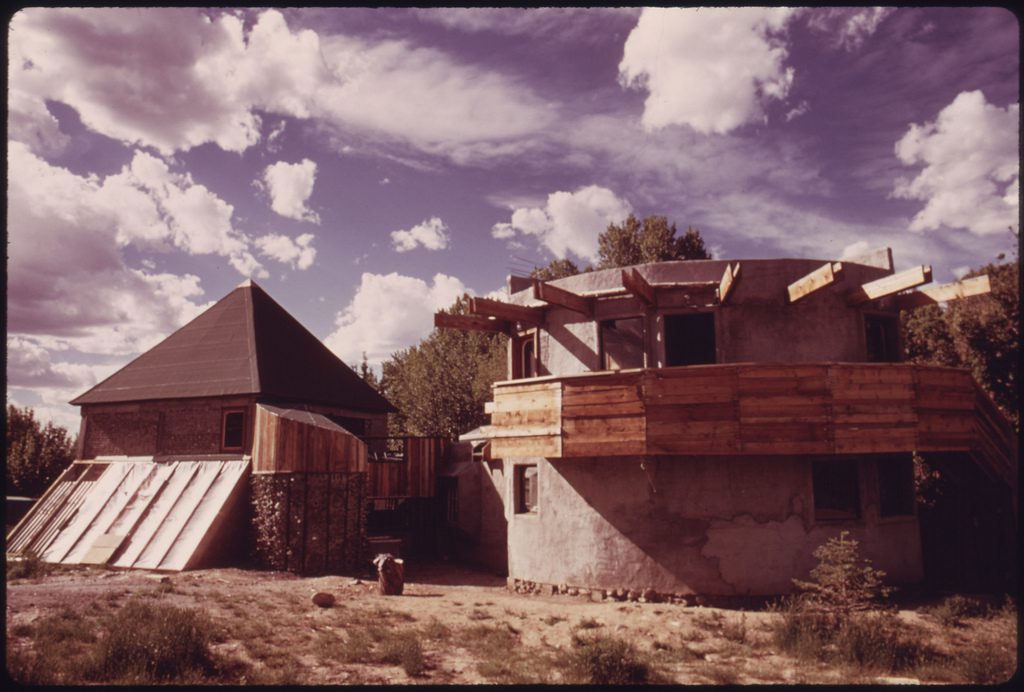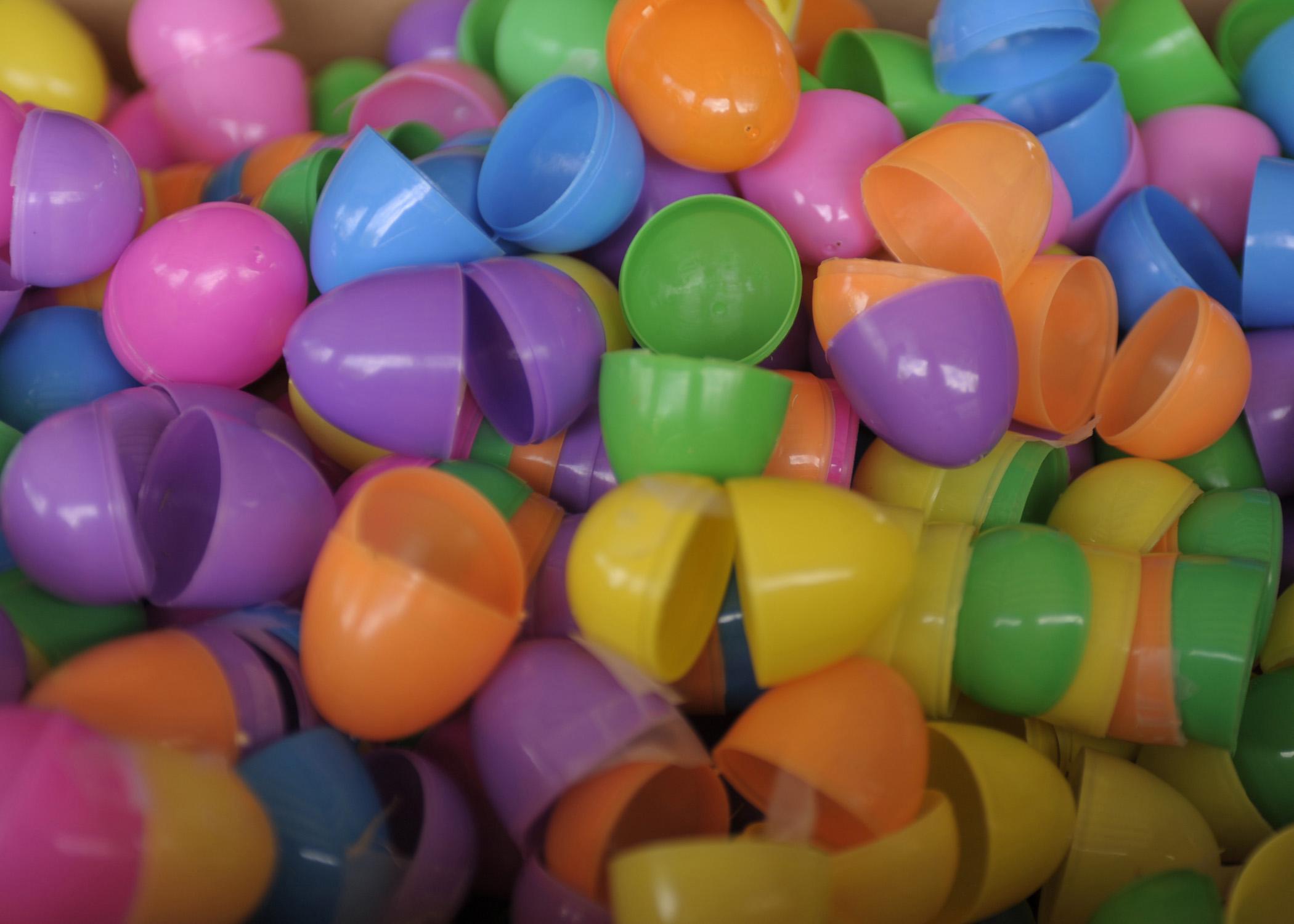At 7 a.m. on Easter morning I have only just remembered that I have not yet cleared the yard of trash—an important task considering that hunting for colored eggs among the strips of white Walmart bags and red Sonic cups would be gross and potentially confusing. My two-year-old might not understand that she is looking for plastic eggs, not plastic lids. I grab gloves and a trash bag and sneak out of the house as my daughters sleep. Squatting in place to peel shredded candy wrappers from the dirt, I unearth a small yogurt cup. I work my way toward the chain link fence that acts as a porous barrier between me and my neighbor. Her yard is littered with garbage and much of it blows through the fence into my yard. The Gatorade containers, Styrofoam take-out boxes, and ginger ale cans suggest that at least some of the trash was chucked over the fence.
My garbage bag is soon bulging, straining with the weight of the trash. Rain has not fallen for ages, but I try not to think about why some of the trash is wet. I circle the yard slowly and each time I approach an area that appears to only contain a few large pieces of trash, closer inspection reveals shards of plastic embedded in the earth. If these were potsherds, this might be more compelling. I consider the ways these plastic pieces will outlive us, the legacy of our oil-based empire. Who might outlive this empire and discover our plastic debris hundreds of years from now?
An hour later, I abandon the remaining bottle caps, splintered straws, and cigarette butts still submerged in the dirt and surrender my garbage bag to my curbside trash bin. Shedding my gloves, I deposit eggs in the crooks of trees, under bushes, and in the fort and sandbox. Some are real, dyed eggs, but most are plastic and filled with pistachios and chocolate covered raisins. I hang two small Easter baskets within easy reach on the limbs of a dead tree.
*
Las Vegas, New Mexico, is a place where the landscape and its people have been abandoned to a slow and steady erosion driven by wind and sun. When speaking with visitors to my hometown, they do not mention the majestic cottonwoods presiding over the slight Gallinas River or the way the Great Plains rise up, fanned and tawny, to greet the foothills of the Sangre de Cristo mountain range that soars to 10,000 feet. They describe a town of crumbling adobe and Victorian buildings, many of which are boarded up. They ask me to explain the graffiti proclaiming the territories of the West Side Locos and East Side Locos. They mention the Big Gulp cups and crumpled McDonald’s take-out bags lodged in gutters and alongside curbs. My backyard faces the railroad tracks and I suspect that the passengers see what I’ve seen on my own train journeys: shabby houses with packed dirt yards, clotheslines, and dirty wide-eyed children. Although they are a fragment of a larger landscape and narrative, backyards can be the easiest places to see and interpret.
There are reasons that the most impoverished communities are the ones where trash clogs the rivers and collects in curb-side gutters. Some days I am quick to point my finger. I mutter about the irresponsibility of my neighbors and scowl at the litter covering their yards. But I know better. Our once-thriving downtown area once boasted two old-fashioned movie theaters, a toy store that sold puppets and wooden toys, a tea and spice company, and two bookstores, among other businesses. Now, the theaters are boarded up and the one remaining bookstore struggles to keep its doors open. The remaining local businesses sell silver and turquoise jewelry and Western paintings to the tourists in the summertime.
Without a healthy local economy, small towns like Las Vegas are hard pressed to find funding for litter-abatement programming. And littering is hardly the biggest problem in a community that has been devalued and discarded, and when people have been relegated to consumer status. The irony here is that it is Walmart, McDonald’s, and Dollar Tree that do the real consuming.
*
Every month I make the hour drive along I-25 from my Las Vegas to Santa Fe. One of my regular stops is Trader Joe’s. I loathe the layers of plastic they swath their produce in, but I appreciate the low prices. The health food store in my hometown is filled with overpriced green fruit that eats into my paycheck at an alarming rate. I confess to my environmental hypocrisy and privilege. I admit to burning fuel to purchase produce that has been shipped to Santa Fe from Argentina. And I concede that I am both undermining my support of a local business and supporting the big businesses I rail against. I make excuses. We all do. Mine go like this: “I only shop there once a month. And, I’m a single mom and can’t always afford health food from the local store.”
If I understand the ways in which we are all pinioned by big box stores, and if I acknowledge my neighbors’ lack of options, perhaps I can make space for hypocrisy so long as it is not accompanied by complacency. I am not the only one who bemoans the derelict state of Las Vegas’s downtown area and the boarded up shops. Ultimately my neighbors and I face the same predicament: there’s nowhere to go but Walmart or Walgreens when you need Band-Aids, batteries, or socks. But are hypocrisy and complacency one and the same? How might I personally take actions that align with my desire to live in a vibrant and thriving community? These are questions I wrestle with frequently.
I know every bend and rise in the stretch of highway that takes me to Santa Fe. In this arid landscape life is a gift, not a promise. The railroad tracks follow the interstate on the northbound side, and Starvation Peak rises above it, not far out of town. Its crumbling red rock pinnacle soars over the jumble of cacti and tumbleweed at its base, thousands of feet below. Beyond Starvation Peak the road winds towards the blue peaks in the Pecos Wilderness outside of Santa Fe. They rise like a mirage out of red rock mesas dotted with juniper and piñon. Billboards along the interstate promote Native American jewelry and upcoming casino shows. Like many highways across the United States, blue “Adopt-A-Highway” signs periodically appear along the route.
Ostensibly, the roadside cleanup service promised through the Adopt-A-Highway program is provided to keep the earth “litter-free,” but the reality is more complicated. In many ways, highways aid in environmental destruction that far outweighs the nuisance of litter. Without I-25, there would be no way to transport nuclear waste from Los Alamos National Laboratories to the Waste Isolation Pilot Plant in Carlsbad, New Mexico. Without a method of disposal, perhaps Los Alamos would be forced to place their toxic waste in their own backyard rather than in a distant community they are not invested in. And without I-25, the beetles carrying Dutch Elm Disease would not be transported at top speed in logging trucks, killing Chinese elms in all the small towns along the interstate from Wyoming to New Mexico. The rampant spread of economy-swallowing big box stores would not be an issue, either, without highways facilitation. Add to this list the human destruction caused by truckers’ cocaine and heroin transport (perhaps the very same truckers resupplying stock at Payless Shoes), and interstates can be understood as more than just a means for long-distance travel.
In this light, the Adopt-A-Highway program is a bandaid for our culture’s waste problem. It affords us the same “out of sight, out of mind” mentality we enjoy with weekly curbside trash pickup. The luxury of trash pickup not only gives us more time for other concerns, but allows us to let go of the concern or responsibility altogether. When trash is buried in far-away landfills or dumped en-masse in the ocean we can disconnect from our products’ perpetual existence. We are not expected to think about the people who deal with our trash on a daily basis—whether they are contracted to work on the roadsides, or whether they are the custodians in our schools or workplaces—or about the communities relegated to live beside landfills.
*
Basura, the Spanish word for trash, is also used to refer to people. The slur is suggestive of a group of people with no class or values, and like most stereotypes, basura are assumed to live in trailer parks, engage in violence, and abuse drugs. Like the term “white trash,” basura is a slur that both condemns and disposes of an entire group, community, or people. However, while “white trash” is qualified by the word “white” –thereby setting a group apart from the rest of the “trash,” basura refers to those at the bottom of the social class order. But terms like “white trash” and basura most accurately reveal those who are doing the defining. Consider what we throw away, and why. Look at what we throw away. Think about the reasons why.
*
More frequent than the Adopt-A-Highway signs along I-25 are the descansos—the adorned crosses that mark where a driver has died—that dot the winding interstate. Descansos are familiar to most in the inland West, but are heavily abundant in New Mexico, where drivers under the influence cause the highest per capita rates of deaths in the nation. I pass a large cross on the left side of the highway. I’ve seen it before, but the adornments look new. Plastic roses thrust into the dirt and gold plastic garlands, draped around the cross, lift with the gust I create. Two minutes later, I see another descanso. This one is planted on the interstate median. It is smaller and more weathered.
In her essay “History Is a Weapon,” Dorothy Allison exposes the experiences of the poor within communities in the American South. People like her family were not actively sought out and killed, she says, but “we were encouraged to destroy ourselves.” This statement suggests both an active and collective destruction, and alludes to a destruction that has been set into motion by external forces. Trash on the streets is not a problem that happens in isolation—it is a symptom of much larger societal challenges.
Like most places in the US, education in Las Vegas, New Mexico, is underfunded. But in small towns and rural areas, no one wants to move in and engage in the daunting task of implementing effective changes in public schools with small-town politics and no budget. With a lack of education and employment opportunities beyond being a cashier at Allsup’s convenience store or the Super Walmart, drugs are often the easiest way to bring in money. Las Vegas serves as a prime example of the relationship between unemployment and substance abuse, supporting a substantial market of alcohol and drug users—crystal meth in particular. Largely considered to be a rural, blue collar drug, meth is relatively cheap and easy to make at home. According to data from the New Mexico Department of Health, the national average for meth use in 2013 was 3.2%. During that same year, my home county of San Miguel had a 9.3% meth-use rate. While Las Vegas does not have the infrastructure to produce the pounds of meth cranked out in the labs of Bernalillo County (the not-so-fictional setting for the popular show Breaking Bad), ounces are produced in kitchens across town. Many businesses, from tattoo parlors and window tinting and frosting businesses to beloved burrito restaurants still operate despite the bleak economy, and are widely known to be fronts. Heroin and cocaine come through on the interstate and the truck stop where truckers and their clients complete their transactions is also part and parcel of local knowledge.
The descansos on the edges of New Mexico’s highways force me to reckon with why there are so many crosses lining the roadsides. Every time I pass a new descanso, I struggle to understand how a cycle can break from within when there is still so much destruction raging through it and so much resistance and ignorance outside of it. I want to honor the memories of those who died on the highway by envisioning and contributing to a community imbued with resilience, not self-destruction. Thriving requires that we value ourselves and each other.
*
Before moving to Las Vegas, New Mexico, my family resided in the small town of Taos, located two hours to the north. Taos is smaller but better known, and is ringed by mountains that rise to 12,000 feet. In Taos, the mesa dotted with sagebrush and prickly pear cactus stretch out in what appears to be an unbroken line until it reaches the distant blue peaks to the west. Though it cannot be seen from town, the Rio Grande gorge regularly entices flocks of visitors to its precipices. This rift in the earth splits the mesa in two, massive red rock cliffs plunging to the river far below. The mesa is not the only thing that is divided in this high country desert. A long history of colonialism and waves of white settlement in the area have created a human rift, too. The Pueblo people continue to live there, as do Hispanic populations, and these overlapping communities make it clear that belonging to this land requires the commitment of many generations. The most common question in Taos is, “Where are you from?” “Taos,” is not a viable answer without the requisite evidence.
The most recent wave of white settlers in Taos consisted of hippies like my parents, migrating west from the East Coast in the 60s and 70s. They sought a simpler life in communes and makeshift, off-the-grid shacks. One of these hippies was a man by the name of Michael Reynolds, who created housing constructed from natural and recycled materials, dubbed “earthships.” Designed to be partially submerged in the ground and to utilize passive solar heat, earthships sought to unite aesthetics, energy efficiency, and recycling. With exterior walls constructed from used tires packed with pounded dirt, and interior walls made from old cans and bottles, an earthship’s frame is composed of trash. Mud, plaster, and cement fill in gaps and hold materials together. Vigas, or large wooden beams, support the roof. Vigas, adobe bricks, and mud mortar were common materials in Pueblo architecture, and Reynolds borrowed these ideas, incorporating them into his designs. But instead of using mud and straw for the interiors of his walls, Reynolds repurposed discarded material both to keep it from a landfill and to create an off-the-grid structure with a light ecological footprint.
As with some initiatives of this nature, earthships have not delivered on all their promises. What began as an inventive architectural endeavor to create eco-friendly, affordable housing has since morphed into a lucrative business. Now, multimillion dollar earthship mansions dot the Taos mesa, and are occupied a few months of the year. Since the wealthy require both aesthetics and functionality, these newer earthships use significantly fewer recyclable materials. The “Reynolds’s hippie houses” of the 1970s are no more. Though the original earthships still exist and are often sold for cheaper prices to those seeking an offbeat lifestyle in Taos, they are often faulty in design. But despite their lesser quality, even the originals have a price tag that runs in the hundreds of thousands of dollars.
When my father describes the time before I was born, I understand that the 70s involved the breaking away from larger social norms to engage in art and innovation. It was a time of renewal. Even so, it is uncomfortable to consider my lineage. I come from a people privileged to be able to consume more, and to turn their trash into futuristic housing. I’m from a culture of people treading the same paths laid down by first the Spaniards and then the enterprising, western-bound settlers at the forefront of Manifest Destiny. I’m from a culture of people who occupied lands that did not belong to them so they could become attuned to the earth and discover themselves. As a result, the Pueblo people have continued to experience a loss of land, livelihood, and culture. And as is true of most indigenous communities across the United States, this drawn-out historical trauma has caused a rise in depression, drug abuse, unemployment, and poverty. Though my family lived in a house with no indoor toilet, and my father and mother worked as a bartender and EMT respectively, we were a part of the hippie community in Taos. We too were white-skinned and oblivious to our role in this ongoing story.
*
Many days I am uncertain about how I should contribute to my community. Picking up my neighbor’s trash wordlessly—but not always uncomplainingly—is not what I consider to be a substantial contribution. Like me, my neighbor Louella Chacón is a single mom. She lives in a Habitat for Humanity house. Like me, she also relies on food stamps and Medicaid to get by. We don’t speak much when we both emerge from our houses on weekday mornings, piling kids into our cars to take them to school. She has relatives in and out of the house several times a week, and many bring their own children. There are often at least five little boys in the yard. They play catch and practice pitching with a plastic bat and a baseball while the adults barbecue. Because their yard is so small their balls often end up in my backyard. One of the oldest boys, about eight, knocks on my door most frequently.
“Ma’am,” he says politely as I open the door. “Can I please get my ball?”
It’s hard to say what Louella makes of the quiet in my yard. I too have friends and relatives nearby, but I go to them.
*
I visit my friend Tara because she is a single mom to four kids, not two. It is easier for me to pack my daughters up and head to her house for coffee and conversation. I bring a watermelon with me one morning, and find her at the stove in her tiny kitchen flipping buttermilk pancakes. The table is crowded with bowls of toppings—whipped cream, berry and chia seed compote, and sliced strawberries. Tara gives me a hug and cup of coffee with cream in it.
“How are you? How’s it going? I’ll just finish these pancakes. Eat! Please, sit down and make yourself at home.” Her questions and urgings are strung together almost breathlessly. Our kids drift in and out of the kitchen also, asking questions, eating pancakes, and chasing the cats. I am happy and comfortable in the warmth of the kitchen, in the midst of this glowing chaos. And although our conversation is punctuated by our children’s requests, we cover a lot of ground, weaving together narratives of family dynamics, heartbreak, writing, and art. I notice a bustier made of chip bags and other trash sitting on top of her stereo and I ask her about it. She explains that she recently took her kids up to Gallinas Canyon to pick up trash.
“I get so tired of all the trash everywhere,” she explains. “I want to teach my kids to respect the earth.” Tara was raised by a Mexican American mother and a Native American father. She was raised to honor the earth, and is dedicated to passing this on to her own children.
“We collected six big bags of trash—that’s all that would fit in my car’s trunk,” she says. “When we got back we sorted it into recycling bins, but there was still so much left that wasn’t recyclable. I didn’t want to throw it away, so I decided to make art.” She gestures to the bustier. Lays and Sun Chips bags are layered on top of Allsup’s burrito wrappers. Much of it is covered with cellophane.
“It’s a female form and I wanted to make a statement about what we are doing to mother earth,” she explains. “We are trashing mother earth.”
Not everyone tolerates the trash that sweeps through my hometown, or uses it for art. We are all simply overwhelmed by the abundance and the enormity of the problem. Trash clean-ups take place a few times a year, and dozens of volunteers show up with boxes of garbage bags. At the end of these clean-ups, the river banks are freed of their plastic garlands and remain this way for a week or two before the trash begins to build back up. Some people clean up on their own, carrying a trash bag when they take daily strolls along the river walk. When I lived near the river, I regularly worked on a small section and once freed three tires from the river’s bottom. But by the time I returned with my car to haul the tires away, someone had rolled the tires back into the water. There are times when trash pickup feels futile. But I am still compelled to pull on gloves once a month and clear my yard.
*
When I step inside my house, I just have time to drop my work gloves and wash my hands when my two-year-old comes pattering out of the bedroom into the kitchen.
“Eggs?” she chirps.
“Yes, eggs!” I exclaim. “Let’s see if your sister is awake.”
My five-year-old is indeed awake and ready for egg hunting. Neither of my daughters wants to waste time changing into the frilly dresses their grandmother purchased for them to wear. I let them head into the backyard in their footed pajamas, one with dancing pink ballerinas, and one with purple penguins. I have hidden the eggs so that my little one can find them, but I soon realize I will have to help her if she has any chance against her big sister. They create piles in separate parts of the yard, and soon they each have a glistening mound of plastic, with a handful of dyed hardboiled eggs mixed in. My daughters are not interested in the hardboiled eggs. The plastic eggs are purple, pink, green, blue, yellow, and orange—a pastel rainbow of treasure that they pile into their Easter baskets. I am unsettled by their delight in the way each plastic egg pops open and snaps closed to reveal and hide their treasures of pistachios, coins, and raisins.
Plastic eggs are flimsy. The two halves are attached by a tiny strip of soft plastic that tears within an hour of being handled by small children. Once torn, one half is often lost or misplaced, rendering the other half unusable. These shiny, plastic eggs are certainly not recyclable. I’m uncertain of how many countless eggs I’ve tossed into the trash over the years. Each deep cleaning of my daughters’ room unearths more unmatched halves. I imagine they are crammed into landfills across the US. I imagine future archaeologists discovering they are on an unintended treasure hunt as they dig into landfills to discover TV sets, cellophane, and plastic egg halves.
My intellectual views on my complicity within a consumer society are often at odds with my actions. Sometimes I imagine the freedom I might gain by discarding plastic eggs, Trader Joe’s groceries, and socks from Walmart by fleeing to an earthship on the Taos mesa to live off-grid and rely on my own sweat and grit. But I also understand that this is not only a privileged response to an overwhelming problem, but a disengagement from both consumerism and responsibility. Ultimately, I consider it my responsibility to make peace with my hypocrisy and strive to make the best personal decisions I can each day. If I believe in community, I cannot contribute to change from outside of it. If there is one advantage to living in a place where litter is prevalent, it is this: when you step into your backyard to discover tissue bushes and plastic bag trees, you do not have the luxury of pretending trash is not a collective dilemma.
My father teaches anthropology at the local community college and he often tells his students that archaeology is just glorified garbology. If it weren’t for human trash there would be little for archaeologists to study. It is mainly through consumption and disposal that we are able to reconstruct civilizations, histories, and cultures. By examining garbage we can better understand what we value. A professor of archaeology at University of Arizona, William Rathje, was among the first in his field to teach his students archeological methods by using modern landfills as excavation sites. He once brought them to the sixty-year-old landfill, Fresh Kills, in New York City, where the team inserted hand augers to bring up strata of garbage. Preserved newspapers from each decade gave them an accurate way to categorize garbage by decade. Among other things, they found food remains still intact from the 1950s. Hot dogs. And guacamole. Things you’d never expect to last.
***

